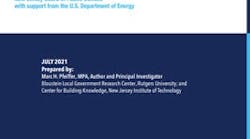This report describes a research project undertaken by the NJ Board of Public Utilities with financial support from the United States Department of Energy through a State Energy Program competitive award. The original purpose of the project was to document and analyze successful approaches to procuring and financing “town center microgrids.” For the purposes of this research, town center microgrids are defined as “microgrids developed in downtown areas of communities that deliver power to a physically non-contiguous group of critical facilities, often involving multiple distributed energy resources and crossing multiple public rights of way.”
This report was initiated by the NJBPU to help inform the Board about New Jersey’s Town Center microgrid efforts. The study found significant value in looking beyond New Jersey’s efforts to consider challenges faced by other states. The report raises issues and recommendations that are broad but frame the issues for individual states as they consider their own energy regulatory, economic, resilience, and reliability needs. The report is expected to assist the Board as it continues its Town Center microgrid efforts.
Town center microgrids are distinct from two other common types of microgrids: 1) singlesite microgrids that serve a single building like a hospital, school, or public housing building; and 2) campus microgrids that are deployed at institutional campuses in government, education, and business sectors to power multiple structures through onsite generation and that provide control to the owner. There are many examples of successful single-site and campus microgrids. Town center microgrids, on the other hand, are far more complicated and are – at least to date – far less common.
This report was prepared as an account of work sponsored by an agency of the United States Government. Neither the United States Government nor any agency thereof, nor any of their employees, makes any warranty, expressed or implied, or assumes any legal liability or responsibility for the accuracy, completeness, or usefulness of any information, apparatus, product, or process disclosed, or represents that its use would not infringe privately owned rights. Reference herein to any specific commercial product, process, or service by trade name, trademark, manufacturer, or otherwise does not necessarily imply its endorsement, recommendation, or favoring by the United States Government or any agency thereof. The views and opinions of authors expressed herein do not necessarily state or reflect those of the United States Government or any agency thereof.
At the time of publication of this report, the Board has made no determinations in response to the modeling, analysis and recommendations contained herein. This information may be used to facilitate the development of microgrids in the future; however, this report does not represent the Board’s views or policies for microgrid development. The Board makes no warranties or representations, expressed or implied, as to the fitness of any proposed methods, processes or other information contained, described, disclosed, or referenced in this report.
This report was authored by Marc Pfeiffer, NJIT/Rutgers Principal Investigator. Comments on this report are welcome at [email protected].
